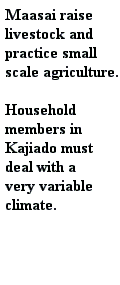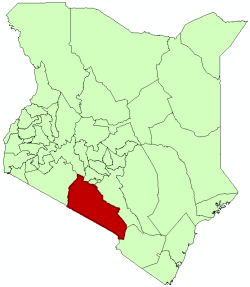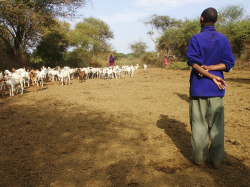 |
||||

|
Maasai in this region traditionally fell into the general category of transhumant pastoralists. However, a number of factors are currently putting pressure on traditional pastoral coping mechanisms and the ability of Maasai herders to maintain extensive grazing patterns. Ongoing land tenure change driven in large part by national policy related to liberalization is a primary driver affecting household decision-making in this system. Since the 1960s, the pastoral landscape has been fragmented through the creation of group ranches and their subsequent subdivision which significantly limits the mobility of herding households. The ecology of this system sets strong limits on the land use options available to pastoralists, and the interaction between land tenure change, an inherently patchy landscape mosaic, and government conservation policies mean that the traditional movement mechanisms of Maasai to cope with variability and drought are now curtailed within increasingly smaller areas. In response pastoralists are making substantial efforts to diversify their production strategies into agriculture (in key resource areas), small business and wage labor. In this rapidly changing economic environment, traditional cooperation and enabling mechanisms (e.g., livestock sharing, stock associations) have less importance in mitigating risk for pastoral households. However, traditional social relationships (i.e., conceptualized as social capital) may remain critical in supporting the exchange of grazing lands in the new context of land privatization. Rising Maasai populations as well as substantial in-migration by non-Maasai are putting increasing pressure on ecological resources, while poor investment in physical infrastructure (e.g., roads, services and markets) again limit the household decision-making options available to Maasai as they seek to mitigate changes in land tenure and ecology, while trying to capitalize on new opportunities represented by economic diversification.
Return to the map of sites.
| |||
 The Kajiado study site comprises four Maasai group ranches; one of which was subdivided into
individual parcels in the early 1990s (Osilalei), and three of which currently remain intact and are
being managed communally by pastoralists (Olgulului/Lolarashi, Eselenkei and Imbirikani). Socio-
economic and grazing movement data were collected from 1999-2001 for 185 pastoral households by
Shauna BurnSilver and Jeff Worden, students at Colorado State University.
A rainfall gradient generally runs north to south across the
10,000 km2 study area, extending from 500?600 mm/yr at the northern edge to a low of 350 mm/yr
in the southern Amboseli Basin. Rainfall patterns are bimodal, but highly variable, with
variation across years of 27%. Vegetation communities in these areas are linked to underlying soil and
topographic gradients. These characteristics translate into an inherently patchy regional landscape,
manifested in vegetation mosaics and uneven biomass quality and quantity across space and time.
Approximately 92% of this landscape has insufficient rainfall for sustained rain-fed agriculture, and
as a result land use in these areas is dominated by extensive pastoralism based on a combination of
livestock species that includes cattle, goats, and sheep. A series of swamps fed by underground
springs extend east-west along the base of Mt. Kilimanjaro. Irrigated horticulture and subsistence
agropastoralism are growing land uses in these areas. Maasai are increasingly sedentarized in their
land-use activities around these ecologically ?key? resource areas and the infrastructural services that
recently have developed around them (e.g., schools, medical facilities, and markets).
The Kajiado study site comprises four Maasai group ranches; one of which was subdivided into
individual parcels in the early 1990s (Osilalei), and three of which currently remain intact and are
being managed communally by pastoralists (Olgulului/Lolarashi, Eselenkei and Imbirikani). Socio-
economic and grazing movement data were collected from 1999-2001 for 185 pastoral households by
Shauna BurnSilver and Jeff Worden, students at Colorado State University.
A rainfall gradient generally runs north to south across the
10,000 km2 study area, extending from 500?600 mm/yr at the northern edge to a low of 350 mm/yr
in the southern Amboseli Basin. Rainfall patterns are bimodal, but highly variable, with
variation across years of 27%. Vegetation communities in these areas are linked to underlying soil and
topographic gradients. These characteristics translate into an inherently patchy regional landscape,
manifested in vegetation mosaics and uneven biomass quality and quantity across space and time.
Approximately 92% of this landscape has insufficient rainfall for sustained rain-fed agriculture, and
as a result land use in these areas is dominated by extensive pastoralism based on a combination of
livestock species that includes cattle, goats, and sheep. A series of swamps fed by underground
springs extend east-west along the base of Mt. Kilimanjaro. Irrigated horticulture and subsistence
agropastoralism are growing land uses in these areas. Maasai are increasingly sedentarized in their
land-use activities around these ecologically ?key? resource areas and the infrastructural services that
recently have developed around them (e.g., schools, medical facilities, and markets).

